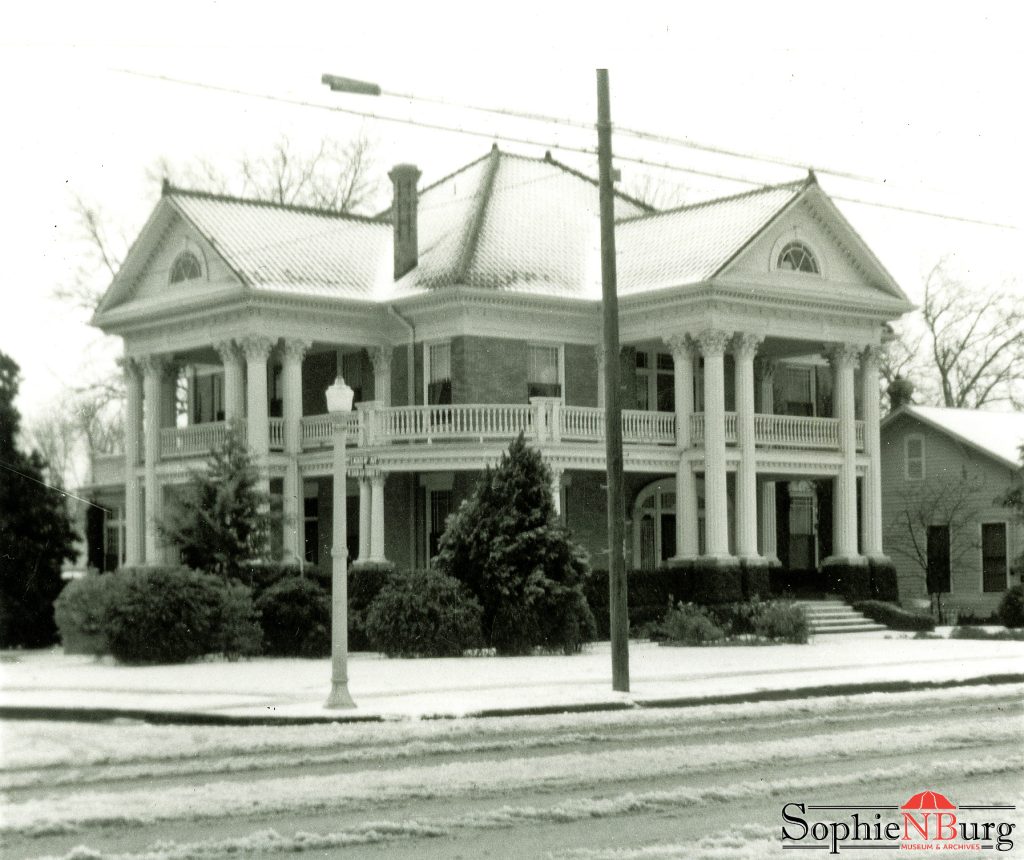
By Tara V. Kohlenberg —
We are fortunate to live in a community proud of its heritage, culture and architecture. Our historic districts and downtown are proof of that pride. It seems so very idyllic, people creating a community by the river, building homes and businesses. The town prospers and new brick buildings to replacing the first crude wooden structures so that they will last. Or do they?
Those that we still see close to Main Plaza seem to be surviving, but a number of lavish 19th- and early 20th-century homes were torn down to make way for business structures. Think Landa mansion or the Timmermann house. I think of them as “ghost homes,” because the memory of their haunting beauty is all that is left.
One such ghost home stood on the corner of W. San Antiono Street and Academy Avenue where it was first occupied by the Holz family. Nicholas Holz, at age 20, immigrated from Germany in 1852. He was a blacksmith and wheelwright by trade who did well over the years. His son, Adolph, joined him in N. Holz & Son Implement Co. and in 1908, they built a large two-story building at 474 W. San Antonio St. to sell farm implements, buggies, and wagons. In 1909, Nicholas retired from business and it was sold to Bartels, Sands & Co.
That same year, Adolph Holz engaged architect Carl von Seutter of San Antonio to design a magnificent home at 417 W. San Antonio St. Von Seutter was well known for designing the now-historic home for Otto Koehler, founder of the San Antonio Brewing Association which became Pearl Brewing Company.
The magnificent home was built by Christian Herry for $15,000 with a crew of about 15, including his sons. Louis Herry was the project superintendent. Son Otto was the masonry foreman and son Alfred was a plasterer. The house was a two-story brick with elements of both Greek Revival and Beaux Arts styles of architecture. The building’s symmetry was offset by gabled front and side-porch porticos. Large, ornate Corinthian columns supported double galleries with heavy balustrades, gracefully wrapping around the front and side of the house.
The opulence of the interior was testament to the owner’s wealth. The grand staircase and house trims were all dark wood. The entry hall floor was parquet laid out in 12-nch sheets. The living room walls had special designs created in plaster to look like large picture frames without the pictures. A mural in a tree pattern was painted on the dining room walls. At the back of the house was a solarium with black and white tiles with a view of a magnolia tree.
The tin roof was crafted to resemble Spanish tile. Beneath the house, a large basement held a washroom and a storage space for wood carried upstairs in a dumbwaiter. Behind the house was a carriage house/livery that eventually became a garage.
After the elder Holzs died in 1910 and 1915, Adolph turned his sales savvy to real estate development. He and his wife raised their four children while enjoying a healthy social life. He was neighbors with George Eiband and Wm. Clemens. Things seemed to go south, however, when multiple lawsuits over real estate compensation were filed against Adolph and wife, Hulda, in the early ‘20s. Multiple properties were sold on the courthouse steps to satisfy their debts, including the implement building at 474 and a storefront at 301 W. San Antonio (now Clay Casa) in 1921. The house was sold to Otto Timmermann Sr. for $19,500 (about $2.5 million today) in 1924 before she and Adolph moved to San Antonio. Hulda died in 1925 after a long illness. Adolph ended up working as a farm laborer in Atascosa County for a time before living out his life with daughter and son-in-law, Ella and Harry Kastener in Milltown.
The next resident of the house was Otto Timmermann Sr. He was the son of Heinrich “Henry” Timmermann, who immigrated in 1850. Mr. Timmermann and wife, Alma Stautzenberger, of Guadalupe County, were farmers. He was said to be the land baron of Geronimo Creek. Upon his retirement, they moved into the old Holz mansion.
Otto Sr. lived in the home about 14 years until his death in 1938. Mrs. Timmermann continued to live in the house on the first floor. After World War II, when returning soldiers took up most of the town’s apartments for rent, Mrs. Timmermann rented out the top floor as a separate apartment. The second floor had a small kitchen, a living room, bedrooms and one bathroom in the hall. One of the bedrooms had six windows. Boarders had to use the back stairs and door, never the main entrance.
Mrs. Timmermann died in 1960. In 1962, the estate sold her house to Rudy Seidel. He used it as a temporary warehouse for hi-fidelity consoles, radios, cameras and electronic flash equipment for Seidel Camera next door. The house was then sold to Howard Hoerster.
It was said that the house had fallen into disrepair, but as a little girl, I looked at that house every time we passed by on the way to my Oma’s house. The grand entryway out front was huge in my eyes. I really wanted to be able to go inside one day, but that was not to be. In January of 1964, the beautiful, old, stately mansion was torn down. I cried. At seven years old, even though I did not know anyone that lived there or how important the architect was, I knew it was a treasure lost and I cried.
Howard Hoerster owned Hoerster Tire & Supply, which was previously located at 270 W. San Antonio St. (now Gourmage). They tore down everything but the large magnolia tree that stood outside the solarium window. They filled in the basement, smoothed it over and built a brand new 6500 square foot brick tire store and service center. The building served thousands of automobiles over time as Hoerster, Goodyear Service Center and DeStefano Tire before being refitted as an office building a couple of years ago.
I have visited Europe and have seen for myself the way different communities hold on to their culture. They still live and work in places that are sometimes 1,000 years old. The structures are proudly maintained for the next generation. Even in areas where war has scarred the land, buildings show dedication to restoration. They are not torn down or drastically altered for the new and trendy. I hope that New Braunfels can embrace and support our historical organizations and commissions in trying to prevent our architectural treasures from becoming “ghosts” as New Braunfels continues to grow at breakneck speed.
Sources: Sophienburg Museum and Archives.
“Around the Sophienburg” is published every other weekend in the New Braunfels Herald-Zeitung.





